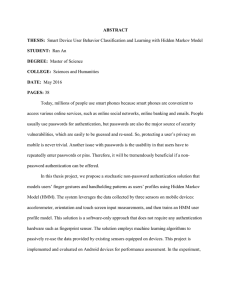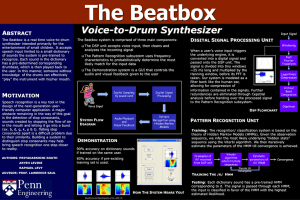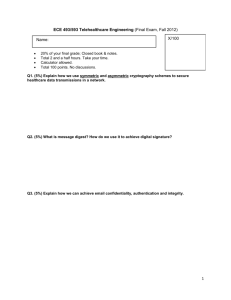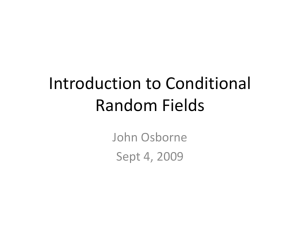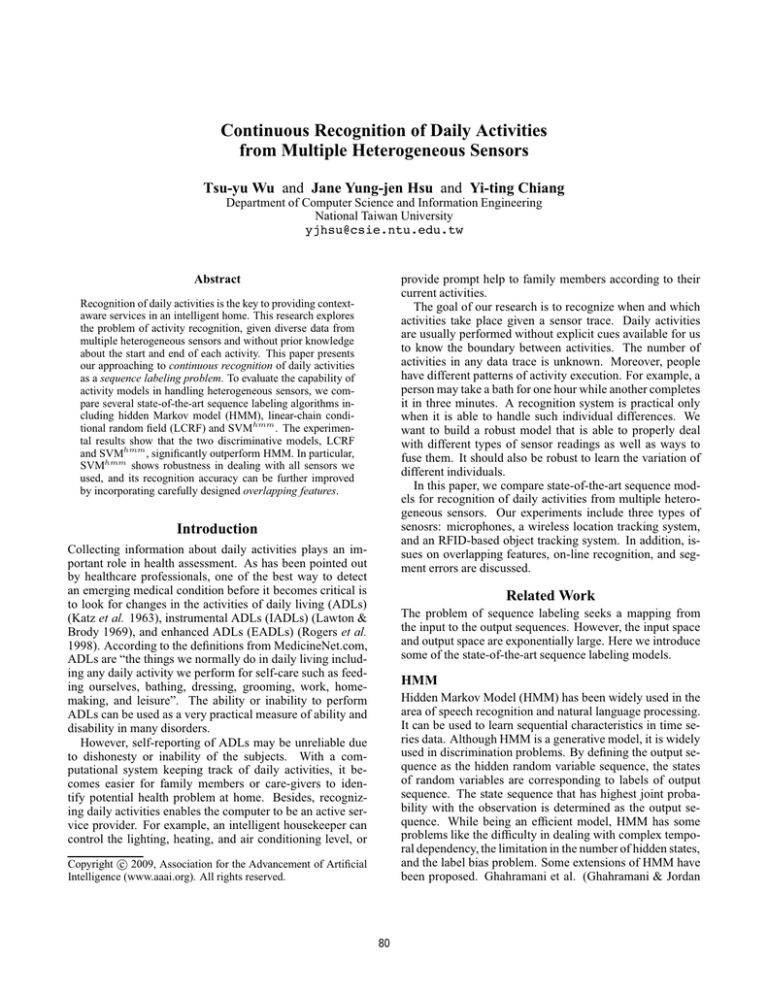
Continuous Recognition of Daily Activities
from Multiple Heterogeneous Sensors
Tsu-yu Wu and Jane Yung-jen Hsu and Yi-ting Chiang
Department of Computer Science and Information Engineering
National Taiwan University
yjhsu@csie.ntu.edu.tw
provide prompt help to family members according to their
current activities.
The goal of our research is to recognize when and which
activities take place given a sensor trace. Daily activities
are usually performed without explicit cues available for us
to know the boundary between activities. The number of
activities in any data trace is unknown. Moreover, people
have different patterns of activity execution. For example, a
person may take a bath for one hour while another completes
it in three minutes. A recognition system is practical only
when it is able to handle such individual differences. We
want to build a robust model that is able to properly deal
with different types of sensor readings as well as ways to
fuse them. It should also be robust to learn the variation of
different individuals.
In this paper, we compare state-of-the-art sequence models for recognition of daily activities from multiple heterogeneous sensors. Our experiments include three types of
senosrs: microphones, a wireless location tracking system,
and an RFID-based object tracking system. In addition, issues on overlapping features, on-line recognition, and segment errors are discussed.
Abstract
Recognition of daily activities is the key to providing contextaware services in an intelligent home. This research explores
the problem of activity recognition, given diverse data from
multiple heterogeneous sensors and without prior knowledge
about the start and end of each activity. This paper presents
our approaching to continuous recognition of daily activities
as a sequence labeling problem. To evaluate the capability of
activity models in handling heterogeneous sensors, we compare several state-of-the-art sequence labeling algorithms including hidden Markov model (HMM), linear-chain conditional random field (LCRF) and SVMhmm . The experimental results show that the two discriminative models, LCRF
and SVMhmm , significantly outperform HMM. In particular,
SVMhmm shows robustness in dealing with all sensors we
used, and its recognition accuracy can be further improved
by incorporating carefully designed overlapping features.
Introduction
Collecting information about daily activities plays an important role in health assessment. As has been pointed out
by healthcare professionals, one of the best way to detect
an emerging medical condition before it becomes critical is
to look for changes in the activities of daily living (ADLs)
(Katz et al. 1963), instrumental ADLs (IADLs) (Lawton &
Brody 1969), and enhanced ADLs (EADLs) (Rogers et al.
1998). According to the definitions from MedicineNet.com,
ADLs are “the things we normally do in daily living including any daily activity we perform for self-care such as feeding ourselves, bathing, dressing, grooming, work, homemaking, and leisure”. The ability or inability to perform
ADLs can be used as a very practical measure of ability and
disability in many disorders.
However, self-reporting of ADLs may be unreliable due
to dishonesty or inability of the subjects. With a computational system keeping track of daily activities, it becomes easier for family members or care-givers to identify potential health problem at home. Besides, recognizing daily activities enables the computer to be an active service provider. For example, an intelligent housekeeper can
control the lighting, heating, and air conditioning level, or
Related Work
The problem of sequence labeling seeks a mapping from
the input to the output sequences. However, the input space
and output space are exponentially large. Here we introduce
some of the state-of-the-art sequence labeling models.
HMM
Hidden Markov Model (HMM) has been widely used in the
area of speech recognition and natural language processing.
It can be used to learn sequential characteristics in time series data. Although HMM is a generative model, it is widely
used in discrimination problems. By defining the output sequence as the hidden random variable sequence, the states
of random variables are corresponding to labels of output
sequence. The state sequence that has highest joint probability with the observation is determined as the output sequence. While being an efficient model, HMM has some
problems like the difficulty in dealing with complex temporal dependency, the limitation in the number of hidden states,
and the label bias problem. Some extensions of HMM have
been proposed. Ghahramani et al. (Ghahramani & Jordan
c 2009, Association for the Advancement of Artificial
Copyright Intelligence (www.aaai.org). All rights reserved.
80
Fox, & Kautz 2007). Shimosaka et al. (Shimosaka, Mori,
& Sato 2007) and we (Wu, Lian, & Hsu 2007) propose using a factored structure of CRF for solving the multi-tasking
activity recognition. Benson et al. (Limketkai, Liao, & Fox
2007) propose a CRF-Filter that is adapted from the particle
filter to solve the on-line recognition problem in localization.
1997) proposed the factorial HMM which allows large cardinality of hidden state in HMMs. A HMM that can deal
with countably infinite number of hidden states can be found
in (Beal, Ghahramani, & Rasmussen 2003). Oliver et al.
(Oliver, Garg, & Horvitz 2004) developed a HMM with layered structure (Layered HMM) that enables the HMM to
learn in different temporal granularities. The LHMM can
be used to decompose heterogeneous signals and lower the
retraining cost when the environment changes.
Structural SVM
SVM is an effective approach for the classification problem. Altun et al. (Altun, Tsochantaridis, & Hofmann
2003) propose an extension of SVM, hidden markov support
vector machine, that handles the sequence labeling problem. A general model for arbitrary output space, structural SVM, is proposed by Tsochantaridis et al. (Tsochantaridis et al. 2005). In an experiment conducted by Nguyen
and Guo (Nguyen & Guo 2007), structural SVM outperforms 5 other state-of-the-art models including HMM,
CRF, Averaged perceptron (AP), Maximum margin Markov
networks(M3N), and an integration of search and learning
algorithm (SEARN) in two sequence labeling tasks, partof-speech (POS) tagging and optical character recognition
(OCR). The experiments show the superiority of structural
SVM in two problems. But in a later technical report
(Keerthi & Sundararajan 2007), CRF is shown to be comparable with structural SVM when appropriate features are
used. In this paper, we also address this issue with the activity recognition problem.
DBN
Dynamic Bayesian network (DBN) is a more general model
that extends BN to represent the temporal relationship between time slices. Rather than a single latent random variable every frame in HMM, DBN allows complex dependency structure of different random variables in and between
time frames. Patterson et al. (Patterson et al. 2003) and
Liao et al. (Liao, Fox, & Kautz 2005) propose different
DBNs that model the complex dependency of the transportation mode, speed, location and GPS readings. Some filtering
algorithm such as Rao-Blackwellized particle filter (RBPF)
favors this kind of factored structured since it allows different filtering strategies for different parts. Wilson (Wilson &
Atkeson 2005) propose an RBPF that estimates the association using the particle filter but estimates the distribution of
the location and activity using Bayes filter. Although DBN is
powerful for modeling complex relationship of multiple random variables, it usually pay for more computational effort.
Exact inference algorithm such as junction tree algorithm
(Smyth, Heckerman, & Jordan 1997) needs exponential inference time if the structure is too complex in DBN. Approximation techniques such as Gibbs sampling and loopy belief
propagation try to solve this problem.
Activity Modeling
We formulate the problem of recognizing daily activities as a
sequence labeling problem, which is to assign a single label
to each element in an observation sequence. In our problem,
the activity is labeled every a fixed interval given the sensor readings. We compare state-of-the-art models including
HMM, linear chain CRF and SVMhmm in this problem. In
this section, we describe briefly how these models are used
in our work. Experimental details will be described in the
next section.
We define the problem as following: Given an observation sequence O = (O1 , O2 , ..., OT ) where Ot is the feature
vector combining data of multiple heterogeneous sensors at
time t, the goal is to generate a sequence of predicted activities A = (A1 , A2 , ..., AT ) where At occurs at time t.
MEMM and CRF
Generative models select the sequence with maximum likelihood of observation. However, sequence labeling is a discrimination problem that predicts the sequence given the observation. Directly modeling the conditional probabilities of
the label sequence given the observation seems more natural for this problem. Maximum entropy Markov model
(MEMM) (Mccallum, Freitag, & Pereira 2000) is a conditional model that uses similar structure of HMM except the
relationship of the observation is inverted. In this way, we
can model dependent observation such as overlapping features and long-term observation without making improper
independence assumption. However, like HMM, MEMM
suffers from the label bias problem due to the per-state normalization.
Conditional random field (Lafferty, McCallum, & Pereira
2001) (CRF) achieves great success in this field by solving
the label bias problem in MEMM using the global normalization. CRF has also been applied in activity recognition.
Chieu et al. (Chieu, Lee, & Kaelbling 2006) and Sminchisescu et al. (Sminchisescu, Kanaujia, & Metaxas 2006)
utilize a linear-chain CRF (LCRF) for the activity recognition problem and show the superiority over HMM. Liao et
al. propose using a hierarchical CRF and iteratively inferring activities and important locations simultaneously (Liao,
HMM
In our work, each activity is modeled as one state of the hidden node in HMM. Each dimension of the observation is
assumed conditionally independent of each other given the
activity. The conditional probability of each discrete feature
given the activity is modeled as a multinomial distribution;
the conditional probability of each real value feature given
the activity is modeled as a mixture of 5 Gaussian distributions. We use the Graphical Modeling Toolkit (GMTK)
(Bilmes 2007) for the implementation of HMM.
Linear Chain CRF
We use LCRF (Lafferty, McCallum, & Pereira 2001) for
the recognition problem. LCRF is an instantiation of CRF
81
that uses similar graphical structure with HMM. CRF models the conditional probability P (A|O) by a set of feature
functions {f1 (A, O, t), f2 (A, O, t), ..., fJ (A, O, t))} and a
weight vector {w1 , w2 , ..., wJ }. The conditional probability
P (A|O) is defined as
exp( j t wj fj (A, O, t))
P (A|O) =
Z(O)
Here we use the same feature functions in LCRF and
SVMhmm .
Unlike the maximum likelihood estimation in CRF and
HMM, structral SVM does not model the probabilities but
discriminate between different label sequences. The learning criteria is similar to conventional SVM that maximizes
the margin. The loss function is the misclassified labels in a
sequence. A cost factor c is used to control the trade off between the margin and loss. Higher c makes the model tend
to fit the training data.
where Z(O) is the normalization constant.
Here we use unigram feature functions between the activity label and a feature value (observation) in the same frame.
For the discrete feature, a set of binary feature functions is
defined for every combination of the activity and the feature
value. For example, we define a binary feature function for
one activity a ∈ A and one feature value o ∈ O as
1, if At = a and Ot = o.
fa,o (A, O, t) =
0, otherwise.
Other Approaches
To evaluate how we benefit from the modeling of the temporal relationship, we use three classifiers, NBC, maximum
entropy classifier (MEC), and SVM for comparison. In this
formulation, each time frame is viewed as an instance and
the activity is independently classified with the observation
in the frame. NBC, MEC and SVM can be viewed as a specialization of HMM, CRF and SVMhmm . Here we use the
same implementation in HMM, CRF and SVMhmm .
For the real value feature, a set of real value feature functions is defined for every activity. The value of the feature
functions is defined as the feature value. For example, we
define a feature function for the activity a and the mean
value of volume (mv) as
x, if At = a and Otmv = x.
fa,mv (A, O, t) =
0, otherwise.
Experiment
We use E-Home dataset as the evaluation dataset. E-Home
dataset is collected in a home-like environment for the research of the activity recognition by Yen (Yen 2007). The
dataset involves 13 subjects and each performs 12 activities.
The order of activities is random and the parts of reading experimental instructions in the trace is manually eliminated.
The dataset consists of totally 27818 seconds and the activity is annotated every second. In the dataset, three primary
kinds of sensors including a microphone in the corner of the
room, a wearable RFID reader and 40 load sensory blocks
on the floor are used. For the audio stream from the microphone, 24 real value features like mean of volume, variance of volume, and mean of zero-crossing rate are extracted
from it. A location system estimates the most active block of
the 40 load sensory blocks by filtering out the deformation
noise. The RFID reader returns null or one of the 24 tagged
objects. The features are extracted every second. We do not
know how many activities occur as well as the duration of
each activity.
More details about this dataset, including RFID deployment and audio features, can be found in (Yen 2007).
where Otmv is the mean of volume at time t.
For modeling the temporal relationship, we use bigram
feature functions between adjacent activities. A set of binary feature functions is defined for every combination of
the activities. For example, we define a binary feature function for the consecutive activities of a as
1, if At−1 = a and At = a.
fa,a (A, O, t) =
0, otherwise.
We choose CRF++ (Kudo 2007) for the implementation
of LCRF. CRF++ is originally designed for discrete features.
We extend CRF++ to handle the real value features. We
predict the activity sequence with the maximum conditional
probability given the observation sequence using Viterbi algorithm. Given the training data D = (D1 , D2 , ..., DN )
where Di = (Ai , Oi ), the learning criteria is to find a weight
vector W that maximizes the log-likelihood of the training
data. A zero mean Gaussian prior is assumed to avoid overfitting. A single variance σ 2 is used to control the degree of
penalization for each weight wi . Higher σ 2 makes the model
tend to fit the training data. L-BFGS (Liu & Nocedal 1989)
is used to train the model.
Performance Measures
The output (P2 , P2 , ..., PT ) is a string of T predictions of
activities. The ground truth (G1 , G2 , ..., GT ) is the annotated activity sequence. According to the E-Home dataset
we used, the cardinality of the output set of these Pi ’s
and Gi ’s are 12, and the time interval of each predicted
and annotated activity is 1 second. To evaluate how our
recognition algorithms perform, we use leave-one-subjectout cross-validation in our experiment. Since the data set
involves 13 subjects, the model is trained using the data sequence containing 12 subjects and tested using the remaining one. The following two accuracy values are used for the
comparisons.
SVMhmm
SVMhmm (Joachims 2008) is a sequence labeling instantiation of structural SVM. Similar to LCRF, structural defines
a linear discriminant function D(A, O) by a set of feature
functions {f1 (A, O, t), f2 (A, O, t), ..., fJ (A, O, t))} and a
weight vector {w1 , w2 , ..., wJ }. The linear discriminant
function D(A, O) is defined as
D(A, O) =
wj fj (A, O, t).
j
t
82
Frame Accuracy The frame accuracy (FA) is the rate
of matching frames between the prediction and the ground
truth.
tures. It seems inappropriate to assume simple distribution
between the activity and the audio features. Fitting parameters to a wrong distribution can result in severe bias. For
RFID, since the event is sparse, there may not be enough
counts for CRF to overcome the prior.
To show the usefulness of temporal relationship, we evaluate how sequence models improve over the frame-based
classification by considering the temporal relationship. The
results of different models are shown in Table 2.
Average Class Accuracy The frame accuracy is easily affected by the long activity. For example, in E-Home dataset,
a system that always predicts the activity as ”watching TV”
can be as accurate as 17% that is much higher than random
guess due to the high coverage of watching TV. The average
class accuracy (ACA) is the normalized frame accuracy by
each activity.
FA/ACA(%)
NBC
MEC
SVM
Classification 35.5/34.2 42.7/39.7 43.7/40.9
FA/ACA(%)
HMM
LCRF
SVMhmm
Sequence Models 40.9/43.1 68.8/64.6 72.0/67.8
Parameter Settings A weight w of the uniform distribution is used to control the smoothness of CPTs used by the
viterbi algorithm in GMTK, the toolkit we used to run HMM
experiments. We smooth each multinomial distribution using a weighted sum of the learned distribution and a uniform distribution. This parameter w is tested from 0.90 to
0.99 and 0.01 in our experiment. The variance σ 2 for LCRF
and the cost factor c for SVMhmm are tested from 2−3 to 24
and multiplied by 2 as a step. The parameters that achieve
highest frame accuracy are used for each model.
Table 2: Performance Comparison of Frame-Based Classification and Sequence Models.
The results show that all sequence models outperform corresponding classifiers in both performance measures. The
improvement of the frame accuracy by considering the temporal relationship can be up to 28.3% in SVMhmm . The improvement of the average class accuracy can be up to 27%
in LCRF. The significant difference shows us frame-based
classification is not adequate in this problem.
Raw Features
We first use the raw features for the evaluation. Raw features
include a 24-dimensional sequence of real value vector for
the audio sensor, a discrete sequence for the RFID system
and a discrete sequence for the location system. The features of these three sensors diverge in form. Audio features
are real value vectors while RFID features and location features are discrete values. In additions, RFID features differ
from location features in sparsity. In E-home dataset, RFID
returns null in 90% of time.
Overlapping Features
Observation can be view in multiple ways. For example,
in natural language processing, the word ”White” can be
viewed as the word itself or a capitalized word. In recognizing the name entity, the capitalization feature may be
very informative. Discriminative models such as LCRF and
SVMhmm are shown to be able to utilize this kind of overlapping features. We describe three different strategies to
extract features in our problem.
Results The results are summarized in Table 1.
FA/ACA(%)
Audio
RFID
Location
Audio+RFID
Audio+Location
Location+RFID
All
HMM
23.5/24.8
44.9/44.1
31.5/37.4
31.9/33.5
39.5/41.9
39.6/45.0
44.3/46.8
LCRF
37.6/27.3
51.4/44.4
43.3/37.1
62.3/54.9
56.3/48.6
63.8/56.8
68.8/64.6
SVMhmm
45.0/36.4
59.5/50.9
40.2/37.5
69.7/63.5
61.0/56.0
65.2/60.3
72.0/67.8
Generative Audio Probabilities The audio in a single
second may not contain sufficient information. In additions,
performing activities may generate different sounds in different stages. For example, in preparing meals, the sound of
chewing can be very different from using microwave.
We use an HMM to model the relationship between a specific activity and a small segment of audio features.
Given the training data, at each time c, we segment a small length l of audio features ScLR =
Audio
Audio
(Oc−l
, Oc−l+1
, ..., OcAudio ) and associate the segment
LR
Sc with the activity label Ac . For each activity i, we
independently train an HMM parameter λLR
using the segi
ments with activity label i. By reversing the time index, we
segment a set of audio features ScRL and train an HMM parameter λRL
for each activity i. As a result, we have 24
i
HMM parameters.
For a testing sequence, we use a backward sliding window
as well as a forward sliding window to segment two audio
sequence of w frames with 50% overlapping. We then use
the 24 HMM parameters to estimate the generative probabilities of the two segments. The probability estimations are
logged and scaled to values ranging from 0 to 1. These 24
Table 1: Performance Comparison of HMM, LCRF and
SVMhmm using Raw Features.
In HMM, the result of fusing all sensors is even worse
than using RFID only. The situation informs us that it can
be dangerous to fuse sensors in a single HMM. Assuming independence for the 24-dimensional audio features in HMM
is dangerous since these features are extracted from the same
audio signal. With discriminative models such as LCRF and
SVMhmm , fusing more sensors generally performs better.
The accuracy of LCRF and SVMhmm using all sensors is
much better than HMM. In our experiment, LCRF performs
slightly worse than SVMhmm . We can see that SVMhmm
show robustness in dealing with varieties of sensors while
LCRF is relatively weak in dealing with RFID and audio fea-
83
Results To show the effect of incorporating these overlapping features, we evaluate the performance of LCRF and
SVMhmm with these overlapping features. The results are
summarized in Table 3 and 4.
FA/ACA(%)
Audio
RFID
Location
All
Figure 1: Generative Audio Probabilities.
CRF
37.6/27.3
51.4/44.4
43.3/37.1
68.8/64.6
SVMhmm
45.0/36.4
59.5/50.9
40.2/37.5
72.0/67.8
Table 3: Performance Comparison of LCRF and SVMhmm
Using Raw Features.
FA/ACA(%)
Audio
RFID
Location
All
CRF
40.1/29.8
63.6/56.8
45.9/39.2
74.8/70.0
SVMhmm
45.9/37.4
63.0/55.4
44.1/40.3
73.0/71.1
Table 4: Performance Comparison of LCRF and SVMhmm
Using Overlapping Features.
By combining these overlapping features, we improve the
accuracy of LCRF and SVMhmm in all sensor settings. Note
that the frame accuracy of LCRF is improved from 51.4% to
63.6% with the NextRFID and LastRFID features because
the two features solve the sparsity of the raw RFID readings. With these features, the performance of LCRF and
SVMhmm is close.
Figure 2: Regions and Sensory Blocks.
probability estimations are used as an additional feature vector. Figure 1 show the process of creating these features.
Region and Region Transitions We group the 40 load
sensory blocks into 3 places including the living room, the
dining room and the workspace. The location feature is the
index of the 40 blocks while the region feature is the corresponding place. In additions, we consider all transitions between these 3 places as additional features. Figure 2 shows
the relationship of the regions and location sensory blocks.
NextRFID and LastRFID When a non-null object is read
by the RFID reader, it is usually very informative for disambiguating activities. Referring to the recent non-null object reading is helpful. For example, if we hold the TV remote control at last 3 seconds, it is very possible that we are
watching TV currently. We define two features, NextRFID
and LastRFID for expanding the raw RFID features.
For non-null object i at the time frame c, if the nearest
RFID reading of object i is at the time frame c where c
is larger than c, NextRFID distance is defined as (c − c).
To prevent referring to the object that is irrelevant in time
frames of other activities, the maximum distance is limited.
In additions, the forward referencing process ended when it
encounters the location change or another object. LastRFID
distance is defined in the same way of the NextRFID except that the order of time frames is reversed. The resulting
distances for objects are scaled to values ranging from 0 to
1. As a result, we have a new 48-dimensional features for
RFID. These features are used as a replacement of the raw
RFID readings.
Conclusion and Future Work
This paper presents our formulation of continuous recognition of daily activities as a sequence labeling problem. We
compare the capacity of several state-of-the-art models including HMM, LCRF, and SVMhmm in handling heterogeneous sensors. In our experiment, discriminative models such as LCRF and SVMhmm significantly outperform
HMM. While LCRF is weak with respect to RFID and audio sensors, SVMhmm is robust in dealing with all types of
sensors in the E-home dataset. To better utilize the sensor
data, we propose strategies for extracting overlapping features. For example, the NextRFID and LastRFID features
significantly improve the accuracy of LCRF by eliminating
the sparsity of the RFID sensor.
This research can be extended in several ways. The Ehome dataset was collected by subjects following instructions in a lab environment. In reality, multiple activities may
be carried out concurrently or with interruption. The highest
frame accuracy of 74.8% in activity recognition, may not be
good enough for practical applications. We plan to explore
additional sensors such as accelerometers and biophysical
sensors to improve recognition.
84
Acknowledgments
Liu, D. C., and Nocedal, J. 1989. On the limited memory
BFGS method for large scale optimization. Mathematical
Programming 45:503–528.
Mccallum, A.; Freitag, D.; and Pereira, F. 2000. Maximum
entropy markov models for information extraction and segmentation. In Proceedings of the International Conference
on Machine Learning (ICML).
Nguyen, N., and Guo, Y. 2007. Comparisons of sequence
labeling algorithms and extensions. In Proceedings of the
International Conference on Machine Learning (ICML).
Oliver, N.; Garg, A.; and Horvitz, E. 2004. Layered representations for learning and inferring office activity from
multiple sensory channels. Comput. Vis. Image Underst.
96(2):163–180.
Patterson, D. J.; Liao, L.; Fox, D.; and Kautz, H. A. 2003.
Inferring high-level behavior from low-level sensors. In
Proceedings of the International Conference on Ubiquitous
Computing (Ubicomp), volume 2864 of Lecture Notes in
Computer Science, 73–89. Springer.
Rogers, W.; Meyer, B.; Walker, N.; and Fisk, A. 1998.
Functional limitations to daily living tasks in the aged: a
focus group analysis. Human Factors 40(1):111–125.
Shimosaka, M.; Mori, T.; and Sato, T. 2007. Robust action
recognition and segmentation with multi-task conditional
random fields. In Proceedings of IEEE International Conference on Robotics and Automation (ICRA).
Sminchisescu, C.; Kanaujia, A.; and Metaxas, D. 2006.
Conditional models for contextual human motion recognition.
Computer Vision and Image Understanding
104(2):210–220.
Smyth, P.; Heckerman, D.; and Jordan, M. I. 1997. Probabilistic independence networks for hidden markov probability models. Neural Computation 9(2):227–269.
Tsochantaridis, I.; Joachims, T.; Hofmann, T.; and Altun,
Y. 2005. Large margin methods for structured and interdependent output variables. Journal of Machine Learning
Research (JMLR) 6:1453–1484.
Wilson, D. H., and Atkeson, C. G. 2005. Simultaneous tracking and activity recognition (STAR) using many
anonymous, binary sensors. In Gellersen, H.-W.; Want,
R.; and Schmidt, A., eds., Proceedings of the International Conference on Pervasive Computing (Pervasive),
volume 3468 of Lecture Notes in Computer Science, 62–
79. Springer.
Wu, T.-y.; Lian, C.-c.; and Hsu, J. Y.-j. 2007. Joint recognition of multiple concurrent activities using factorial conditional random fields. Technical Report WS-07-09, AAAI
Workshop on Plan, Activity, Intent Recognition (PAIR).
Yen, C.-n. 2007. Utilizing heterogeneous sensors for everyday activity recognition. Master’s thesis, National Taiwan University.
This work was partially supported by grants from the National Science Council, Taiwan (NSC 96-2628-E-002-173MY3), Excellent Research Projects of National Taiwan University (97R0062-06), and Intel Corporation.
References
Altun, Y.; Tsochantaridis, I.; and Hofmann, T. 2003. Hidden markov support vector machines. In Proceedings of the
International Conference on Machine Learning (ICML).
Beal, M. J.; Ghahramani, Z.; and Rasmussen, C. E. 2003.
The infinite hidden markov model. Advances in Neural
Information Processing Systems 14 577–584.
Bilmes, J.
2007.
The Graphical Models Toolkit
(GMTK).
http://ssli.ee.washington.edu/
˜bilmes/gmtk/.
Chieu, H. L.; Lee, W. S.; and Kaelbling, L. P. 2006. Activity recognition from physiological data using conditional
random fields. Technical report, Singapore-MIT Alliance
(SMA) Annual Symposium.
Ghahramani, Z., and Jordan, M. I. 1997. Factorial hidden
markov models. Machine Learning 29(2-3):245–273.
Joachims, T. 2008. SVMhmm : Sequence Tagging
with Structural Support Vector Machines. http://
svmlight.joachims.org/svm_struct.html.
Katz, S.; Ford, A.; Moskowitz, R.; Jackson, B.; and Jaffe,
M. 1963. Studies of illness in the aged: The index of
ADL: A standardized measure of biological and psychosocial function. Journal of the American Medical Association
185(12):914–9.
Keerthi, S. S., and Sundararajan, S. 2007. CRF versus
SVM-struct for sequence labeling. Technical report, Yahoo
Research.
Kudo, T. 2007. CRF++: Yet Another CRF toolkit. http:
//crfpp.sourceforge.net/.
Lafferty, J.; McCallum, A.; and Pereira, F. 2001. Conditional random fields: Probabilistic models. for segmenting
and labeling sequence data. In Proceedings of the International Conference on Machine Learning (ICML).
Lawton, M., and Brody, E. 1969. Assessment of older people: self-maintaining and instrumental activities of daily
living. Gerontologist 9(3):179–86.
Liao, L.; Fox, D.; and Kautz, H. A. 2005. Location-based
activity recognition using relational markov networks. In
Proceedings of the International Joint Conferences on Artificial Intelligence (IJCAI), 773–778. Professional Book
Center.
Liao, L.; Fox, D.; and Kautz, H. A. 2007. Extracting places
and activities from GPS traces using hierarchical conditional random fields. International Journal of Robotics Research 26:119–134.
Limketkai, B.; Liao, L.; and Fox, D. 2007. CRF-Filters:
Discriminative particle filters for sequential state estimation. In Proceedings of IEEE International Conference on
Robotics and Automation (ICRA).
85

